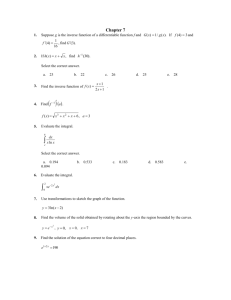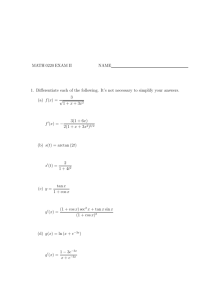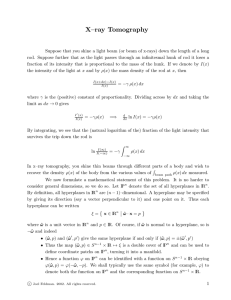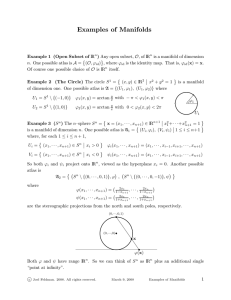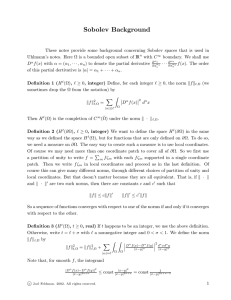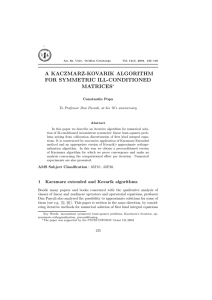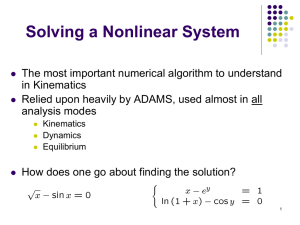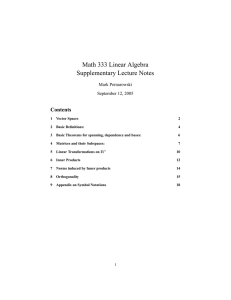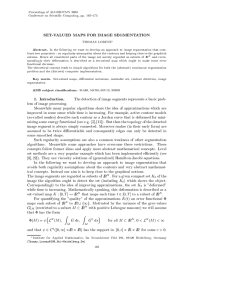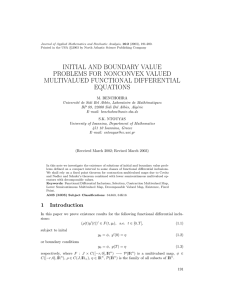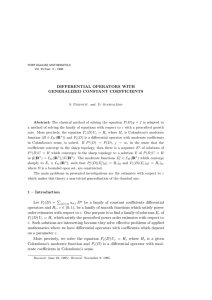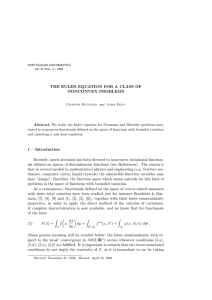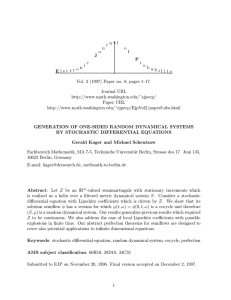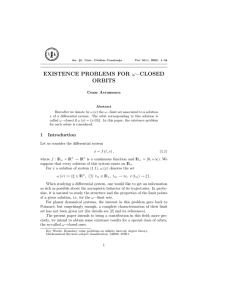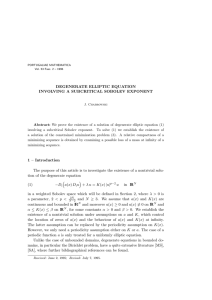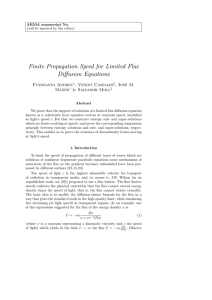1 univariate calculus
advertisement
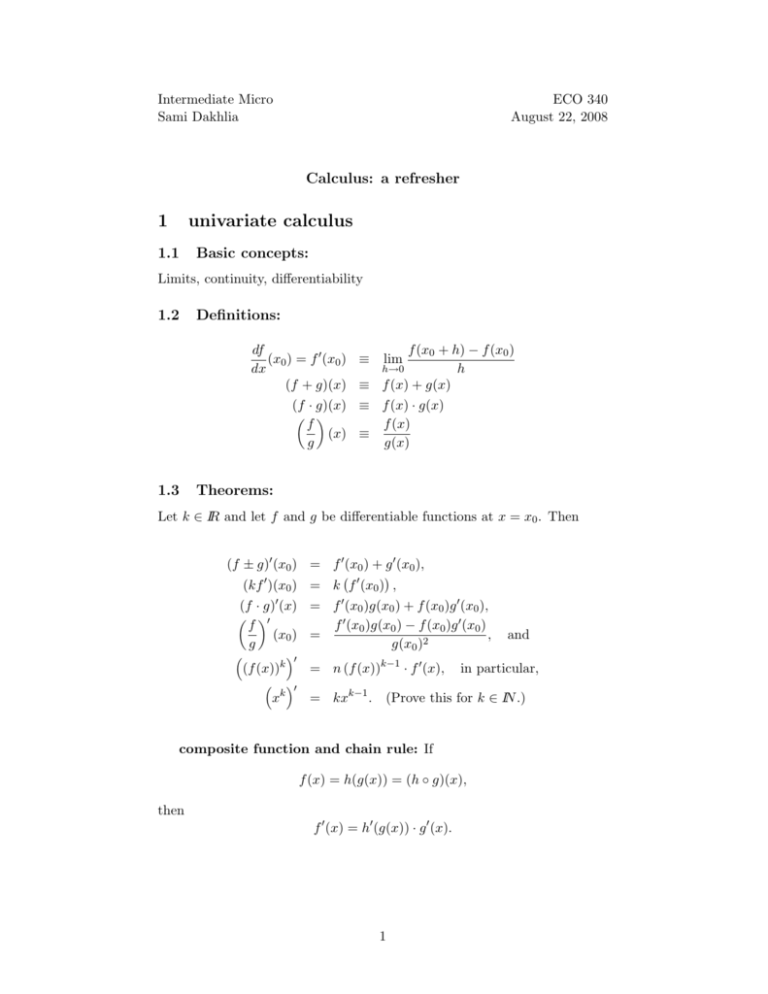
Intermediate Micro Sami Dakhlia ECO 340 August 22, 2008 Calculus: a refresher 1 univariate calculus 1.1 Basic concepts: Limits, continuity, differentiability 1.2 Definitions: df f (x0 + h) − f (x0 ) (x0 ) = f 0 (x0 ) ≡ lim h→0 dx h (f + g)(x) ≡ f (x) + g(x) (f · g)(x) ≡ f (x) · g(x) f f (x) (x) ≡ g g(x) 1.3 Theorems: Let k ∈ IR and let f and g be differentiable functions at x = x0 . Then (f ± g)0 (x0 ) = f 0 (x0 ) + g 0 (x0 ), (kf 0 )(x0 ) = k f 0 (x0 ) , (f · g)0 (x) = f 0 (x0 )g(x0 ) + f (x0 )g 0 (x0 ), f f 0 (x0 )g(x0 ) − f (x0 )g 0 (x0 ) (x0 ) = , g g(x0 )2 0 (f (x))k xk and 0 = n (f (x))k−1 · f 0 (x), 0 = kxk−1 . (Prove this for k ∈ IN .) in particular, composite function and chain rule: If f (x) = h(g(x)) = (h ◦ g)(x), then f 0 (x) = h0 (g(x)) · g 0 (x). 1 1.4 Inverse Function Theorem: Let f be a C 1 function defined on the interval I ⊆ IR. If f 0 (x) 6= 0 for all x ∈ I, then: 1. f is invertible on I, 2. its inverse g is a C 1 function on the interval f (I), and 3. for all z in the domain of the inverse function g, g 0 (z) = 1 f 0 (g(z)) . This theorem is used to prove the power rule for k ∈ Q (and hence for k ∈ IR by density argument). 1.5 Some functions: exp, ln, sin, cos, tan lim ln(1 + x) = x x→0 (ln x)0 = 1/x (ln f (x))0 = f 0 (x)/f (x) df (x) x d ln f (x) · = dx f (x) d ln x x 0 x (e ) = e (eu (x))0 = u0 (x)eu (x) (sin x)0 = cos x (cos x)0 = sin x π π ) = − sin(x − ) 2 2 π π sin x = − cos(x + ) = cos(x − ) 2 2 sin x tan x = cos x cos2 x − sin2 x = 1 − tan2 x (tan x)0 = cos2 x cos x = sin(x + 1.6 Taylor series linearization (univariate) 1. Approximation of order one: R(h; a) ≡ f (a + h) − f (a) − f 0 (a)h, where R(h; a) = 0, h→0 h lim 2 by definition of the derivative f 0 (a). When h is around 0.01, R(h; a) is roughly 0.001. 2. Approximation of order two: 1 R2 (h; a) ≡ f (a + h) − f (a) − f 0 (a)h − f 00 (a)h2 , 2 where R2 (h; a) = 0, h2 by definition of the derivative f 00 (a). When h is around 0.01, R2 (h; a) is roughly 0.00001. lim h→0 3. kth order Taylor polynomial of f at x = a: Pk (a + h) = f (a) + f 0 (a)h + 2 1 00 1 f (a)h2 + · · · + f [k] (a)hk . 2! k! multivariate calculus 2.1 Basic concepts: Limits, continuity, differentiability 2.2 Partial derivative: Definition: Let f : IRn 7→ IR. Then for each variable xi at each point x0 = (x01 , . . . , x0n ) in the domain of f , f (x01 , . . . , x0i + h, . . . , x0n ) − f (x01 , . . . , x0i , . . . , x0n ) ∂f 0 (x1 , . . . , xn0 ) ≡ lim , h→0 ∂xi h if this limit exists. 2.3 Total derivative: 2.4 Definitions: Jacobian: Let F : IRn 7→ IRm be C 1 . Then the Jacobian derivative of F at x∗ is the matrix J = DF (x∗ ) = ∂f1 ∗ ∂x2 (x ) ∂f1 ∗ ∂x1 (x ) .. . ∂fm ∗ ∂x1 (x ) ··· .. . ∂fm ∗ ∂x2 (x ) · · · ∂f1 ∗ ∂xn (x ) .. . . ∂fm ∗) (x ∂xn Hessian: Let f : IRn 7→ IR be C 2 . Then the Hessian is the square and symmetric matrix H = D2 f (x) = ∂2f (x) ∂x1 2 2 ∂ f ∂x1 ∂x2 (x) ∂2f ∂x2 ∂x1 (x) ∂2f (x) ∂x2 2 ··· .. . ··· .. . ∂2f ∂x1 ∂xn (x) ∂2f ∂x2 ∂xn (x) ··· .. . 3 ∂2f ∂xn ∂x1 (x) ∂2f ∂xn ∂x2 (x) .. . ∂2f (x) ∂xn 2 . 2.5 Chain rule: df d ∂f dx1 ∂f dx2 ∂f dxn · · · = (f (x(t)) = + + ··· + dt dt ∂x1 dt ∂x2 dt ∂xn dt Alternatively: Let F : IRn 7→ IRm and A : IRs 7→ IRn be C 1 functions. Let s∗ ∈ IRs and x∗ = A(s∗ ) ∈ IRn . Consider the composite function H = F ◦ A : IRr 7→ IRn . Let DF (x∗ ) be the m × n Jacobian matrix of the partial derivatives of F at x∗ and let DA(s∗ ) be the n × s Jacobian matrix of partial derivatives of A at s∗ . Then, the Jacobian matrix DH(s∗ ) is given by the matrix product of the Jacobians: DH(s∗ ) = D(F ◦ A)(s∗ ) = DF (x∗ ) · DA(s∗ ). 2.6 convexity and quasi-convexity 2.7 Implicit functions and their derivatives y = F (x1 , . . . , xn ) is an explicit function since the endogenous variable y can be put on the left hand side. Often this is not possible as in (example) or in more general terms: G(x1 , . . . , xn , y) = c. Generalized Implicit Function Theorem: Let G(x1 , . . . , xn , y) be a C 1 function around the point (x∗1 , . . . , x∗n , y ∗ ). Suppose further that this point satisfies G(x∗1 , . . . , x∗n , y ∗ ) = c and that ∂G ∗ (x , . . . , x∗n , y ∗ ) 6= 0. ∂y 1 Then, there is a C 1 function y = y(x1 , . . . , xn , y) defined on an open ball B about (x∗1 , . . . , x∗n , y ∗ ) so that: 1. G(x1 , . . . , xn , y(x1 , . . . , xn , y)) = c ∀(x1 , . . . , xn ) ∈ B, 2. y ∗ = y(x∗1 , . . . , x∗n ), and 3. for each index i, ∂G (x∗1 , . . . , x∗n , y ∗ ) ∂y ∗ i (x1 , . . . , x∗n ) = − ∂x . ∂G ∗ ∗ ∗ ∂xi ∂y (x1 , . . . , xn , y ) 4


